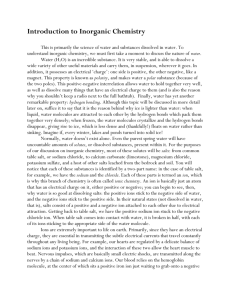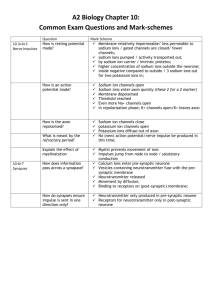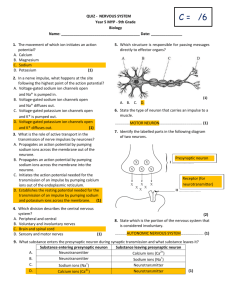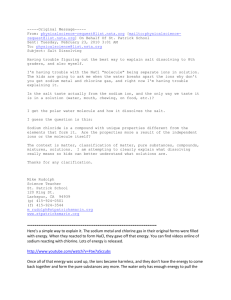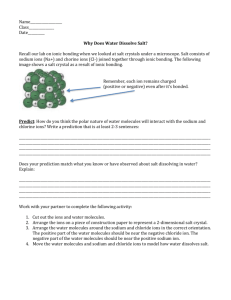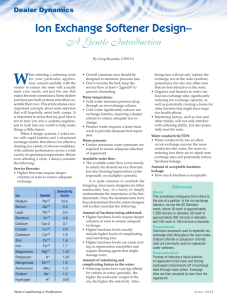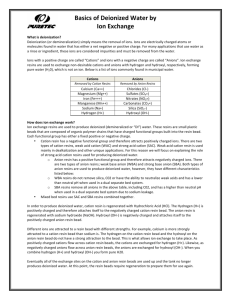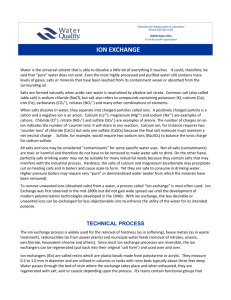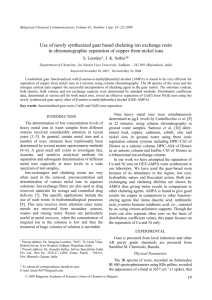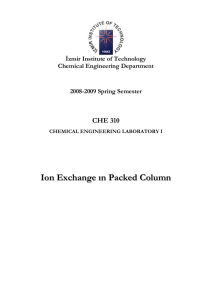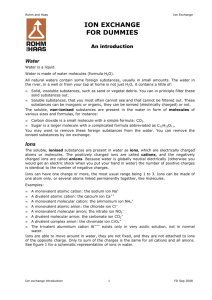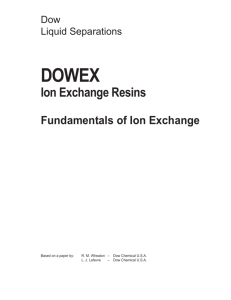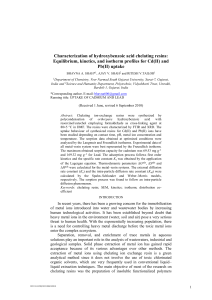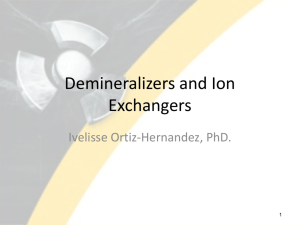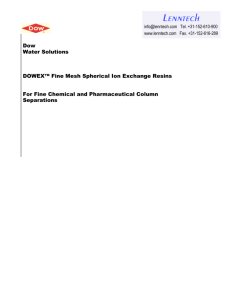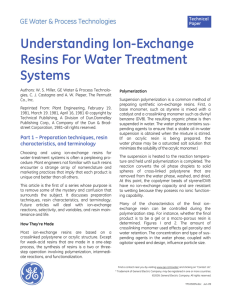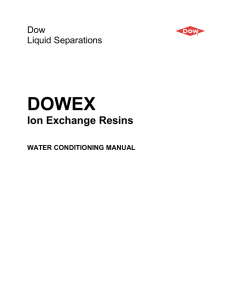Background
advertisement
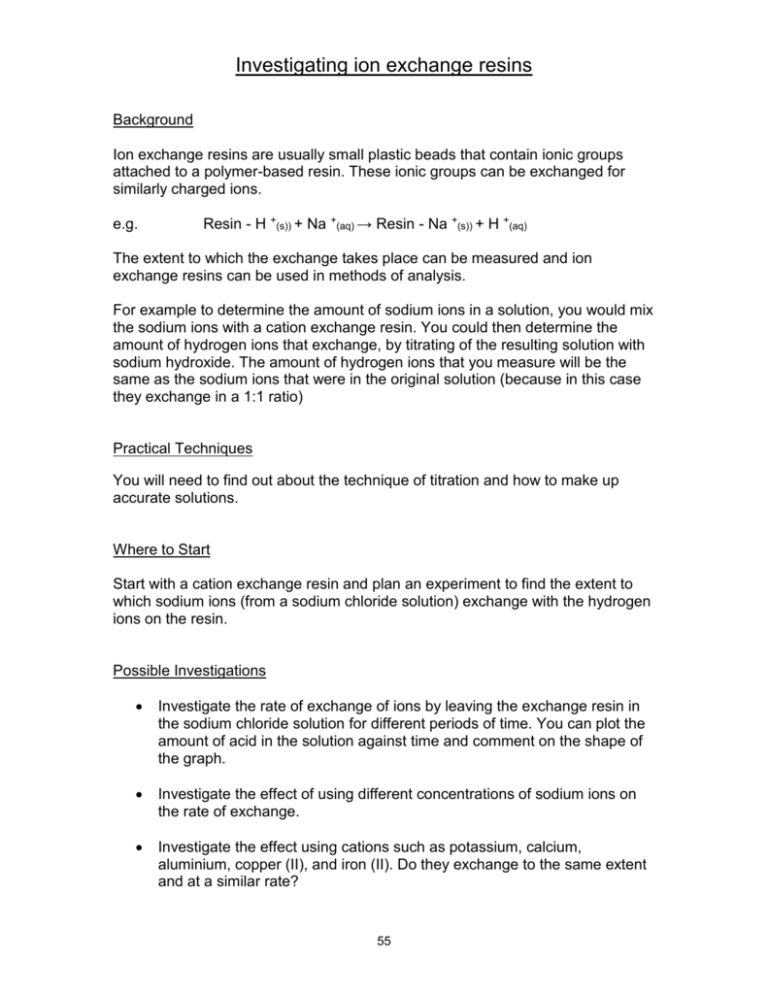
Investigating ion exchange resins Background Ion exchange resins are usually small plastic beads that contain ionic groups attached to a polymer-based resin. These ionic groups can be exchanged for similarly charged ions. e.g. Resin - H +(s)) + Na +(aq) → Resin - Na +(s)) + H +(aq) The extent to which the exchange takes place can be measured and ion exchange resins can be used in methods of analysis. For example to determine the amount of sodium ions in a solution, you would mix the sodium ions with a cation exchange resin. You could then determine the amount of hydrogen ions that exchange, by titrating of the resulting solution with sodium hydroxide. The amount of hydrogen ions that you measure will be the same as the sodium ions that were in the original solution (because in this case they exchange in a 1:1 ratio) Practical Techniques You will need to find out about the technique of titration and how to make up accurate solutions. Where to Start Start with a cation exchange resin and plan an experiment to find the extent to which sodium ions (from a sodium chloride solution) exchange with the hydrogen ions on the resin. Possible Investigations Investigate the rate of exchange of ions by leaving the exchange resin in the sodium chloride solution for different periods of time. You can plot the amount of acid in the solution against time and comment on the shape of the graph. Investigate the effect of using different concentrations of sodium ions on the rate of exchange. Investigate the effect using cations such as potassium, calcium, aluminium, copper (II), and iron (II). Do they exchange to the same extent and at a similar rate? 55 Investigate the extent and /or rate of exchange of coloured ions such as copper (II) by colorimetry. Compare this method to the titration method. Investigate anion exchange resins Investigate the use of ion exchange to purify water. Investigate the use of ion exchange to separate ions. You could place the resin in a column such as a burette and pass down a solution containing a known mixture of ions. You could then analyse the filtrate to determine its composition. Sources of Information Womack N., Ioning out the problems, Chemistry Review, March 1998 Denby D., Ion Exchange Resins, Chemistry Review, March 1998 Robertson K.J.A., Gray C., Wood,C.A. (2001) Starter Investigations for Advanced Higher Chemistry, Royal Society of Chemistry Farley R., (2001), School Chemistry Experiments, Association for Science Education. Thorpe A., Assessing the risks in practical work, Chemistry Review, September 2000 Thorpe A., Experimental error and error analysis: just how good are those results, Chemistry Review, November 2001 Thorpe A., Making a standard solution, Chemistry Review, November 2002 Ferguson M., Volumetric Analysis, Chemistry Review, September 1996 Battye P., Titrations, Chemistry Review, February 2003 56 Teachers' Notes General The experimental techniques are fairly straightforward and most students should be able to obtain good sets of results. Chemical Principles Ion Exchange, Equilibrium Essential Equipment Burettes, pipettes, cation exchange resin Essential Chemicals Hydrochloric acid, sodium hydroxide, methyl orange Safety No risk assessment has been given. It is essential that students prepare a detailed risk assessment before they start. Teachers must be satisfied that this is suitable for the proposed investigation. 57 Experiment Starter Sheet – Investigating ion exchange resins Place about 2 grams of a cation exchange resin into a filter paper in a filter funnel and wash it through twice with moderately concentrated (about 3 mol dm-3) hydrochloric acid to convert it to its hydrogen form. This should be followed by washing the resin with distilled water until the filtrate is neutral. The resin should then be placed in to a 250 cm 3 beaker and stirred well with about 50 cm3 of distilled water. Add 10 cm3 of 0.1 mol dm-3 of sodium chloride solution and stir well. Filter off the resin and titrate the remaining solution with a 0.1 mol dm-3 solution of sodium hydroxide. You can use methyl orange as an indicator. 58
